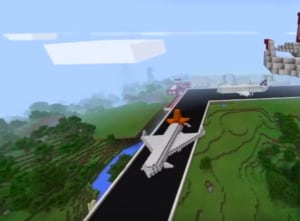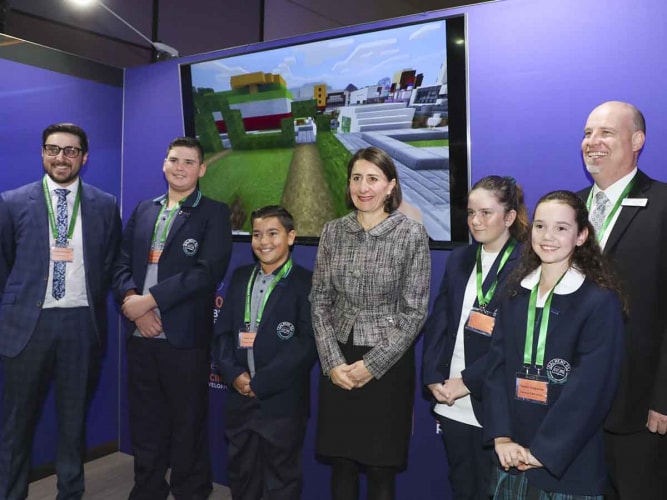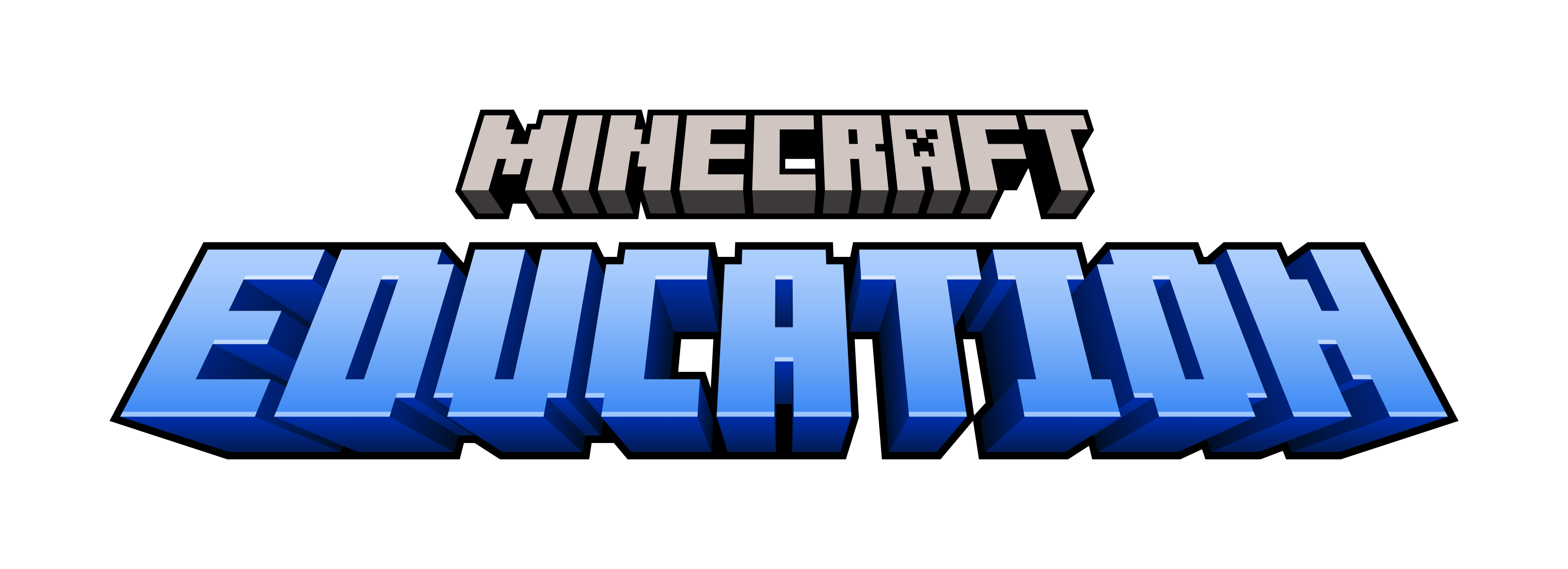Liverpool City Council Aerotropolis Project

This guest blog post on the Liverpool City Council’s Minecraft design project was written by Global Minecraft Mentor and educator Bron Stuckey. Read more about the competition in this media release.
The Liverpool City Council Aerotropolis Project is a design competition that came about through the auspices of the Liverpool City Council in New South Wales, Australia. The idea grew out of a conversation between Andrew Stevenson the Council’s Communications Manager and the Council’s Chief Executive Kiersten Fishburn. Her son loved Minecraft and in discussion about how to positively engage the local community it was suggested that a Minecraft build competition could fit the bill. After all, students in year four in 2018 finish school in 2026 and would likely play out some part of their lives in this Aerotropolis.
Andrew Stevenson used to work for the Minister for Education and knew people in the Department would be excited by the aim “To engage Primary-aged students in understanding the concepts of an Aerotropolis, changes in land use and career opportunities using Minecraft as a design and learning platform” (Liverpool City Council, 2018). Council supported the project with an information pack, online resources and, where possible, school visits led by planners and an amazing $10,000 STEM prize to the winning school (lesser sums to the 2 runners up).
So, what would a successful and sustainable Western Sydney Airport and its Aerotropolis look like? Liverpool City Council provided a design brief, judging criteria and documentation that would guide student research. As part of the design thinking process students developed impressive research and survey skills. They were guided to build their knowledge by examining other modern airport cities including very futuristic cities like Songdo in South Korea or the mini-city planned by Google for its NASA campus.
Floating airplane docks, personalised transport systems, see-through buildings and a zoo are just part of the winning futuristic vision Dalmeny Public School students have for a new airport precinct in western Sydney.
One School’s Story
One school that entered a team in the competition was Dalmeny Primary School. Teacher Daniel Melissari played Minecraft in his late teenage years and was excited to get his school involved. He attended the Minecraft Education Edition teacher training on offer for the project run by Microsoft Learning Consultant Megan Townes. Daniel found that this Education Edition of the game, had many new features for him to learn. Having been a player himself may have given Daniel an inroad to the technical attributes of the game, but now through his educator lens he began to see how it could be used to enhance so many areas of his curriculum.

Daniel spoke to some parents before the competition and they were keen for their children to engage in this. An expression of interest (EOI) was put out to the students across the grades. Students had to respond describing their Minecraft experience and what they felt they could bring to the project. Teachers from Year 6 met to judge the entries. Teachers considered what the students brought to the project as well as how each might benefit from engagement (looking at the social aspect and creating friendships) and a team likely to complete to a high standard. A team of 20 selected students from across several classes in years 4 to 6 would make the library their home base for the three weeks of the project.
Daniel met with the team to kick off the Aerotropolis design. Students were assigned research to complete at home (totally voluntary but all of them did it) to find and share functioning airport cities from around the world (e.g. Ft Worth International airport in Dallas). From this research the group was to come up with their own definition of an ‘Aerotropolis’: An Aerotropolis is a city which is built in close proximity to an airport. It includes plenty of jobs, schools and has a transportation system. (e.g. trains, buses, and boats or ferries).
In planning, the group decided to survey the Year 6’s as they were going to be the students that would first be using the Aerotropolis for work, study and socialising in the future. They asked year 6 students what they wanted and used their own definition to explain to them what an Aerotropolis was. The school holidays came and the group used Microsoft teams to remotely collate data from the survey and host a discussion board to finalise inclusions.
Back at school after the holidays using Minecraft: Education Edition, the group began looking for a suitable site. Daniel had chosen a multiplayer world with contours and vegetation (not flat) as the students needed to consider the environment and understand processes like land clearing that often precede development. After a site was agreed upon barriers were placed on the site to ensure the build did not exceed the required dimensions. Daniel’s decision about landscape paid off in the student designs, as they worked hard to retain as many features of the natural environment as possible. “Their design was built around the existing contour of the land and included a number of features that paid homage to the environmental aspects of the area and to the traditional indigenous land owners,” explained Mr Reedie, Dalmeny Principal.

Working on butcher’s paper scaled to the required dimensions, and informed by decisions made from the survey results, they began to allocate areas of the Aerotropolis (university, mall, office buildings etc.). They came up with rough estimates for the dimensions of each project and then returned to Minecraft to section off areas for each. Students were broken into teams and each team given responsibility for a specific project. Teams had complete creative control over their projects but had to research directions taken by similar projects in the physical world. For instance, the space station student team researched Cape Canaveral, and the Johnson Space Centre in Houston to gain inspiration for their project. After a team thought they had finished creating it they would seek feedback from other students on how they might improve their project. Once improved to the point where everyone was happy they moved on to the next section. Students who finished also headed to other areas to assist with the other team’s projects. Students gained a lot from reading and returning to the design brief, learning to design to required specifications.
For the competition, the students were required to submit screen shots and a narrated 3-minute video to describe and explain their design choices. Watch as Isaac guides you around the Aerotropolis to see not only the airport but STEM high schools, a university, a hospital, a zoo, an aerospace facility and provisions for modern shopping and transport.
Learning gains and assessment
This was very personal and authentic for these students. The airport in their local area, very near their school, and they were designing in a tool that they knew well. The confidence of the students in this group also sky-rocketed as a lot of shy students could shine and be rewarded for the hard work they did. One student, from the support unit who would be going on to a mainstream class for high school, built his first new relationships.

One of the issues Daniel faced came about through working, in the library with students pulled from different classes designing, over 4 very short weeks. All the students voluntarily gave up their own breaks to complete this task and Daniel gave up his personal class relief time to facilitate sessions that pulled the whole group together. To further accommodate design in the tight time frame, students built in their teams and then worked together to refine their final designs. Time was left in every whole group session for the students to debrief. They frequently revisited the design brief and offered advice to improve designs to ensure the brief was well met.
The cross-year activity worked well albeit difficult to schedule and for everyone giving up free time to work together. In doing this project again Daniel said he would still do a cross grade team because it allows those students who normally go unnoticed a real chance to shine.
Where to from here?
The pilot of the Liverpool City Council’s Minecraft Competition: Build the Western Sydney Aerotropolis ran for 3/4 weeks in April of 2018 and 13 schools competed to create visionary designs. The competition will run next for the full length of Term 1 2019. Training takes place Term 4 2018.
Daniel now visualises how subjects from writing to geography can be explored through Minecraft Education Edition. He has started using it in his own classroom as a tool to enhance the learning outcomes. And is looking forward to incorporating Minecraft Education Edition more and more into his upcoming learning activities and very likely in his Natural Disasters Unit.

Teacher Daniel Melissari (far left) with student representatives, NSW Premier Gladys Berejiklian and Dalmeny Public School principal Clayton Reedie.
Students examined the project brief and then researched the issues surrounding the Badgery’s Creek Airport and the purpose of the Aerotropolis. In iterative rounds of design interspersed with review, peer feedback and advice, they refined and built their vision. To share their design, they took screen shots of their main features and created a video flyover of the full in-world Aerotropolis with voice over and music.
You might follow in Daniel’s footsteps to give your students a chance to contribute to the discourse about significant local developments? Is there already a local planning or design project that your students could contribute to? Or could you lobby a local authority of company to get one started?
About Daniel Melissari, in his words: I have taught Year 6 at Dalmeny Public School since 2015. I am the lead teacher across my grade for incorporating technology within the curriculum. In early 2018 my school was presented with the opportunity to compete in Liverpool City Council’s Minecraft Competition: Build the Western Sydney Aerotropolis, an airport city in Badgerys Creek. Having played Minecraft as a late teenager, I readily embraced the opportunity to lead a select group of students through this competition. A team of 20 from across several classes made the library their home base for three weeks to complete this project.
Supporting media:
- The Urban Developer Western Sydney ‘Aerotropolis’ Gets $20bn Funding Boost
- NSW Department of Education: Sky’s the limit for Minecraft competition winners
- Liverpool City Council Winners of $10,000 Minecraft competition take their design to the world


